

Paywall model breakdown: The current landscape and new frontier - Chartbeat Blog. As publishers continue investing in reader-driven revenue streams, the question of which paywall model — or models — to pursue or experiment with has been a hot topic among many of our partners.
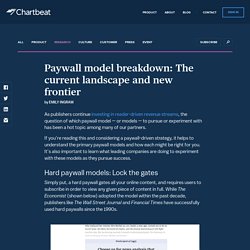
If you’re reading this and considering a paywall-driven strategy, it helps to understand the primary paywall models and how each might be right for you. It’s also important to learn what leading companies are doing to experiment with these models as they pursue success. Simply put, a hard paywall gates all your online content, and requires users to subscribe in order to view any given piece of content in full. While The Economist (shown below) adopted the model within the past decade, publishers like The Wall Street Journal and Financial Times have successfully used hard paywalls since the 1990s. Newsonomics: CEO Mark Thompson on offering more and more New York Times (and charging more for it) There’s friction.
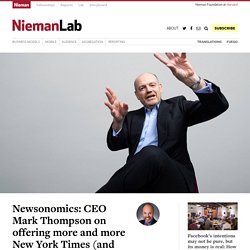
And then there’s stupid friction. Everyone in the subscription business decries friction, putting too many steps between the would-be buyer and the buy itself. Enter your credit card number; type in your address; pick a username and password; sorry, your password must have at least 3 uppercase characters, 2 lowercase characters, a number greater than 6, and any two of %, &, and #.
Too many words, pages, clicks. AIMC lanza medición “Brand Media” EGM/Comscore - ProgPublicidad. Local News Initiative. The financial bedrock of the American news industry has shifted radically, with advertising revenue no longer able to support the journalism that the public has long depended upon.
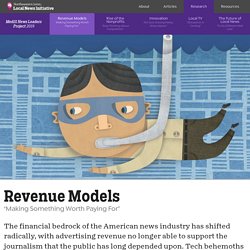
Tech behemoths like Facebook and Google are reaping much of the ad money that once went to local news outlets. According to the Pew Research Center, the newspaper industry’s ad revenue fell 13 percent in a single year, from 2017 to 2018. Guardian sets goal of 2m supporters in next stage of ambitious strategy. The Guardian has set a target to attract 2 million paying supporters in the next three years, with the aim of securing the future of its journalism output in a tough media environment.
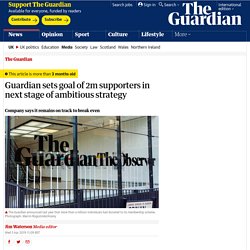
After a three-year period during which costs have been reduced, revenues increased and the landmark of 1 million paying contributors across web and paper reached, the editor-in-chief, Katharine Viner, and the Guardian Media group chief executive, David Pemsel, unveiled the next stage of their strategy. “One of the great successes of the past three years has been the willingness of readers to support our journalism and our purpose,” they said in an email to staff on Wednesday. “As we look ahead, we are setting a new goal for the whole organisation: to attract 2 million people to support the Guardian financially by the end of our 200th anniversary year, in 2022.” “Three years ago, the Guardian faced severe financial challenges,” they said in the memo. Guardian sets goal of 2m supporters in next stage of ambitious strategy. Publishing News UK: Guardian Turns a Profit. “The Guardian has been consistently loss-making,” read the Wikipedia entry on the publication, till yesterday.
It was quickly edited after the British daily announced that The Guardian and the Observer have broken even—for the first time in 20 years—aided by record online traffic, reduced costs and increased financial contributions from readers. “Guardian News & Media recorded an £800,000 operating profit for the 2018-19 financial year – compared with a £57m loss three years previously,” the company said, “ensuring the business is existing on a sustainable basis following the culmination of a turnaround programme put in place following years of substantial losses.” This is a remarkable feat in an extremely challenging market, especially since The Guardian’s model is unique among news publishers. It keeps its journalism outside a paywall, while asking readers to contribute to help subsidize its reporting. By Monojoy Bhattacharjee Related posts. Publishing News UK: Guardian Turns a Profit. Publishing News UK: Guardian Turns a Profit.
Publishing News UK: Guardian Turns a Profit. Inside the Guardian's journey to profitability. "On the whole, there were pockets who entirely believed that it was possible, and there were others who genuinely had some concerns and doubts, because some of the numbers that we were putting against things like our reader revenues were pretty hefty," he said.

"And the reality was, over three years, we didn't necessarily have a detailed financial plan, but we did have a framework, and that framework was made up of some assumptions in the outer years around what we'd be getting from some of these numbers. "I remember looking at the ones in the advertising world thinking, how on earth are we going to go from where we are now to that? " Nicklin credits this framework with pushing people to do things differently, and says that it focused people's minds in the business. Are Paywalls Saving Newspapers? Media outlets large and small have adopted digital paywalls to augment dramatic declines in print revenues, but given their negative effect on website traffic (and, in turn, online advertising), are paywalls an effective sales strategy?
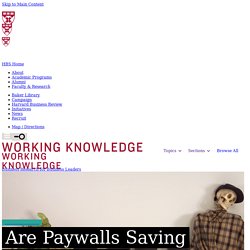
A new study that incorporates data on the four primary revenue components of traditional newspaper companies—print subscription, print advertising, digital subscription, and digital advertising—finds that for companies with high circulations and large amounts of exclusive content, paywalls can increase overall sales, often by increasing demand for print subscriptions.
Newspapers with less exclusive content, however, have generally experienced losses when they started charging readers to access digital editions, according to the research, which studied major newspaper firms in the United States. Total upheaval. ¿Pagarías por leer noticias? Los medios avanzan hacia ese modelo. With a heavy marketing push, The New York Times passes 3 million mark in paid digital subscribers. The New York Times ended the third quarter with more than 3 million paid digital subscribers to its main news product and crosswords and cooking verticals, the company announced today.
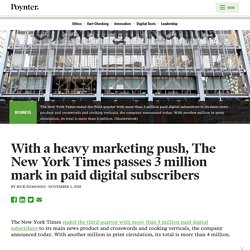
With another million in print circulation, its total is more than 4 million. For the quarter, the Times added just over 200,000 digital subscribers net: 143,000 for the main news product, another 60,000 for the two specialty sites. That result was achieved only with a heavy marketing push, Times executives explained in a conference call with financial analysts. What it takes to shift a news organization to reader revenue. Launching a paywall is easy.
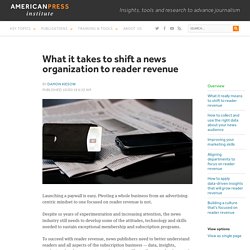
Pivoting a whole business from an advertising-centric mindset to one focused on reader revenue is not. Despite 10 years of experimentation and increasing attention, the news industry still needs to develop some of the attitudes, technology and skills needed to sustain exceptional membership and subscription programs. Anuncios de rich media que más engagement generan para tu marca - Antevenio. ¿Por qué no hay un Spotify para noticias? How The New York Times plans new subscription products. Dear Publishers, if you want my subscription dollars (or euros), here is what I expect… Netflix frente a Hollywood: la supremacía de los modelos analíticos. De Correspondent gets cash injection from Omidyar Network for global launch. De Correspondent, a reader-funded news publisher based in the Netherlands, announced Monday that it has raised $950,000 from Omidyar Network—an investment fund set up by billionaire eBay co-founder Pierre Omidyar—to finance the launch of a global version of the site known as The Correspondent.
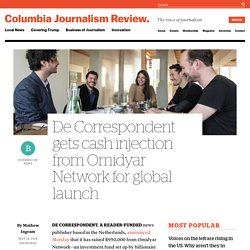
The new funding brings the total raised for that expansion to $1.8 million. De Correspondent launched in 2013 with a crowdfunding effort that raised $1.7 million and has grown steadily ever since, funded primarily by its readers (which it prefers to call “members”). The site now has more than 60,000 paying subscribers. The headquarters of the global version will be in the US. Co-founder Ernst-Jan Pfauth, the former head of digital strategy for the Dutch newspaper NRC Handelsblad, said the funding from Omidyar Network will allow De Correspondent to undertake a marketing campaign for its expansion. Download the DIS 2018 speaker presentations. View and download the speaker presentations from the Digital Innovators' Summit, 18-20 March, Berlin.

Please note that we will ONLY share those presentations we have been given permission to share by the speakers. Available presentations are listed below. Any problems/questions? Ask Sylkia. How the New York Times is convincing commercial partners to pay for its journalism. The New York Times had a wish list. It wanted coverage of the emerging human subcultures that young journalists can be so adept at spotting, and it wanted to report them in a way that was visually arresting and likely to thrive on social media as well as its own platforms. Its solution was a remarkable project called Surfacing, which has generated features on subjects as diverse as a female “Roller Derby” team made up of members from indigenous peoples from around the world, and the Black Panther “cosplayers” who like to dress up in the outfits of characters from the recent Hollywood fantasy film. But perhaps stranger than all of that is the fact that this editorial project from the world’s most famous newspaper title is underwritten by a snack brand, Véa, a trendy cracker made without artificial ingredients.
Introducing Subscribe with Google. What Could Blockchain Do for Journalism? – Welcome to Blockchain. Billionaire-Proofing the News When Ricketts shuttered Gothamist and DNAinfo, and when Thiel’s lawsuit killed Gawker, there was a real danger that the crucial journalism all three sites did would not only cease, but be wiped from history entirely, their archives expunged. The immutability and permanence of information on the blockchain would make that nearly impossible. “They’re ‘billionaire-proofing’ journalism, and I think that’s crucial now,” Moore says of Civil. Civil is being developed in partnership with Consensys, a software incubator for applications on the Ethereum platform. Ethereum’s token, ether, is the second-largest cryptocurrency after bitcoin, with a market cap of over $70 billion; while bitcoin is largely a medium of exchange and investment, Ethereum is a customizable full-service platform onto which applications like Civil can be built. ADC - Video Estrategias Marketing Digital 2018.
Ingresos por suscripción: 1000 millones de dólares para The New York Times. The New York Times vuelve a demostrar con sus cuentas que las suscripciones pueden suponer la fuente de ingresos más importante para los diarios. La compañía editora ha presentado las cuentas de 2017 y la partida de ingresos por suscripcion supera ya los 1.000 millones de dólares, suponiendo el 60% de los ingresos totales de la compañía. Solo en el último trimestre del año, el diario norteamericano ha añadido 157.000 suscripciones nuevas, lo que ha impulsado el crecimiento de los ingresos en esta partida un 46% y los totales del grupo en un 8% en el último año, compensando en parte la caída de ingresos por publicidad que en 2017 fue del 3,8% .
El presidente de la compañía, Marc Thompson aseguraba que las cuentas de 2017 eran “una clara señal de que nuestro modelo de negocio poniendo en primer lugar a las suscripciones está siendo efectivo para apoyar nuestras amplias ambiciones periodísticas”. Ingresos por suscripción: 1000 millones de dólares para The New York Times. Morning MediaWire: What the new L.A. Times owner can learn from Jeff Bezos. Patrick Soon-Shiong has shown incredible determination, imagination and belief in himself in rising from discrimination in apartheid South Africa to become a billionaire in Los Angeles — and he has given hope to one of America’s great newspapers. Now he’s going to have to trust others in a field he knows little about, if he wants his newest acquisition, the Los Angeles Times, to bloom again.
In two words, show humility, says an author who has been following billionaires buying media properties. Trust and humility are what Jeff Bezos, the world’s richest person, has shown since buying the Washington Post in 2013, says Dan Kennedy, author of of "The Return of the Moguls: How Jeff Bezos and John Henry Are Remaking Newspapers for the 21st Century. " WordPress Barcelona: ¿Cómo monetizar nuestro proyecto web? Formatos de publicidad nativa (native ads) In the digital age, The New York Times treads an increasingly slippery path between news and advertising - Columbia Journalism Review. The April 2 edition of the Sunday New York Times, where the paper features its best journalism, included a six-page special section, “Women Today,” pegged to a summit in Manhattan a few days later.
Steven King: “Las empresas periodísticas no pueden depender de la publicidad” The New York Times CEO on state of digital advertising: ‘Nightmarish joke’ Pay Models in European News - Reuters Institute Digital News Report. Matthew Kaminski, de 'Politico': 'El consumidor de un periódico tiene que pagar' The definitive guide to personal newsletters – Revue – Medium. Publicidad y apocalipsis » Enrique Dans. Here’s how this Norwegian publisher built a successful digital subscription model for local news. The current move to subscription models is a revolutionary shift for journalism – Poynter. Demonising the Duopoly won’t save journalism. La prensa escrita asiste al desprendimiento de los 100.000 ejemplares en venta. 18 formatos publicitarios online que ponen (con razón) los pelos de punta al internauta - Marketing Directo.
Washington Post Licenses Publishing Technology to Tronc - WSJ. 3 razones por las que tu agencia de marketing debería utilizar un CRM. How Newsletter Metrics Can Turn Into Revenue. Seis modelos de negocio para el periodismo en la era de las plataformas. Flush from its Trump-bump, ProPublica is staffing up to cover the president – Poynter. A subscription-based news ecosystem, if you can keep it — Quartz. Rise of the Platishers - Recode. Ad-Supported Digital Media Isn’t Dying, Says Quartz President. The Financial Times passes another major digital milestone. Digital Ad Revenues Grow 19% Year-Over-Year in First Half of 2016, Hitting Landmark High of $32.7 Billion. Don't hold your breath for Trump TV- POLITICO Media.
Log In. Some Publishers Worry About Viability of Branded Videos on Facebook. Sports Illustrated Teams Up With Fox Sports for Ad Deal. Native Advertising: Another False Messiah? — Whither news? 98 personal data points that Facebook uses to target ads to you. Twitter Shares Research About Video Ad Impact, Tips For Working With Influencers. Twitter: Video Ads In Social Feeds Are Twice As Memorable As Pre-Rolls On Premium Sites. ¿Qué publicidad hacer según tu estrategia de precios? Brand content now part of half of CNN International ad deals. Havas presenta en sociedad su tercera red de agencias de medios: FullSix Media. Here are 6 reasons why newspapers have dropped their paywalls. Facebook limita el alcance orgánico para ser más rentable. MAC 2016 La televisió per IP : una realitat multidimensional. Nuevos formatos publicitarios de Google basados en la geolocalización - Noticia - Medios. New Yorker Instagram Followers Debate Ads After Mag’s Paid Post.
¿Quieres hacer el favor de pagarme, por favor? 32 vías de ingresos para el periodismo. The SXSW16 Stolen Manifesto. ¿Cómo mejorar la publicidad en medios? Primera regla: satisface al usuario — Hoja en blanco. Quartz revenue strategy: ‘We'll do whatever makes sense for the user’ Quartz revenue strategy: ‘We'll do whatever makes sense for the user’ Si creía que la televisión había muerto, debería saber que ha resucitado con hambre de ROI. ABC Study Makes the Best Case Yet That TV Advertising Is Still Superior to Digital. 7 Ways to Ensure You Maximize Your ROI From Content. Cómo definir un perfil de audiencia o ‘buyer persona’ vía. El engagement está en crisis vía. ¿Qué son los activos digitales? ¿Qué es Publicidad Móvil?. Concepto y tipos.
Guía para principiantes para calcular el ROI en redes sociales. Diferencias entre CPC, CPM, CPL y CTR. Guía para principiantes para calcular el ROI en redes sociales. Cómo medir y calcular el Social Media ROI. Las 30 verdades del Social Media ROI.